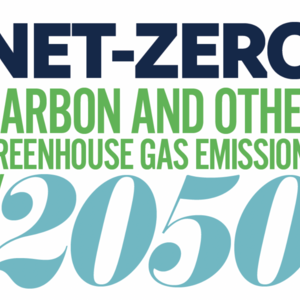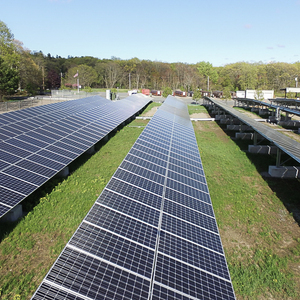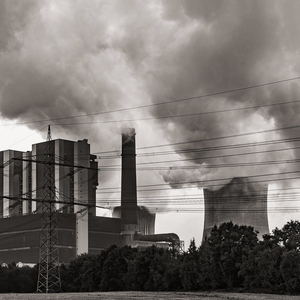
Reaching carbon neutrality by the middle of the century will require a lot more solar and wind capacity as well as new transmission lines, but it can be done at a net cost of about $1 per person per day, a new report claims.
Zero net emissions by 2050 will hold the rise in global warming to 1.5 degrees Celsius and prevent the most damaging effects of climate change, according to the Intergovernmental Panel on Climate Change. There are a number of ways to reach that goal, the report finds, but they typically include several common strategies: higher energy efficiency, cleaner energy, a wider adoption of electric technologies, and some carbon capture.
Researchers from the Lawrence Berkeley National Laboratory, the University of San Francisco, and the consulting firm Evolved Energy Research collaborated on the study.
In announcing the findings, the Berkeley Lab said the study was the first detailed, peer-reviewed roadmap for reaching carbon neutrality that involved making a detailed model of the entire U.S. energy and industrial system. The approach allowed researchers to see numerous ways of reaching carbon neutrality that had not been apparent in the past.
The report, published earlier this year in the journal AGU Advances, said the various pathways to carbon neutrality all could meet projected U.S. energy needs at a cost of between 0.2-1.2% of Gross Domestic Product. The plans did not call for exotic new technologies or the premature mothballing of the existing power infrastructure. Instead, the plans relied on only “commercial or near-commercial technologies.”
“No one is asking consumers to switch out their brand-new car for an electric vehicle,” said Margaret Torn, Berkeley Lab senior scientist and one of the lead authors of the study, in a written statement. “The point is that efficient, low-carbon technologies need to be used when it comes time to replace the current equipment.”
Pathways to carbon neutrality varied. The cheapest approaches were based on at least 80% wind and solar electricity while a 100% renewable energy system was possible but would cost more and require more dedicated land.
“In the next decade,” the report says, “the actions required for all pathways were similar: expand renewable capacity 3.5 fold, retire coal, maintain existing gas-generating capacity, and increase electric vehicle and heat pump sales to more than 50% of market share.”
The cost estimate of $1 day per person is “significantly” less than estimates of a few years ago because of recent advances in energy technology.
Berkeley Lab boiled down the report’s key recommendations to these eight steps that would be needed by 2030:
- Increase solar and wind generating capacity to 500 gigawatts (GW), 3.5 times what it is now.
- Eliminate coal from most electricity generation.
- Keep the current natural gas−generating capacity for reliability.
- Increase sales of zero-emission vehicles to 50% of the total.
- Increase the sales share of heat pumps for heating and cooling buildings to 50% of the total.
- Adopt strict efficiency goals for all new buildings and appliances.
- Invest in R&D for carbon capture and sequestration as well as carbon-neutral fuels.
- Build new transmission lines for electricity and new pipelines for carbon dioxide and hydrogen gas.
Many means to the same end
In all, researchers modeled eight different scenarios to learn how variables such as land use, energy costs, and consumer preferences would affect the outcome. These models were compared to a business-as-usual approach to energy, called the “reference” scenario. The cheapest path to carbon neutrality, called the “central” scenario, would see a reduction in C02 emissions of 84% below 2020 levels by 2050. Other models studied the impact of limiting the amount of land available for solar and wind, delayed consumer adoption of electric devices, lower consumer demand for energy, and using renewable sources for 100% of all primary energy.
One interesting conclusion was that gas-fired power plants should not be retired too quickly. The reason, researchers said, is that gas generation can balance out prolonged periods of high electrical demand and low output from renewable sources. On windy days, when demand was low, solar and wind produced excess electricity, which could be used in a variety of ways. No gas generation would be needed. But on days without much wind and lots of demand, gas plants would have to be brought online.
Just how much output from gas would be needed depends on the length of time that renewable output was low and demand on the system remained high.
“Energy storage was not competitive in meeting sustained energy deficits because the large quantity of energy needed required a large investment in storage, while the infrequent occurrence of such events resulted in very low storage utilization,” the authors noted. “These results illustrate why proposals for rapid retirement of gas-fired capacity are ill advised.”
While batteries weren’t economical for balancing demand and output for long stretches of time, they look like a cost-effective way of evening out production and demand over the course of a day.
Neither the cost nor the reliability of renewable-energy systems looks to be the biggest challenge, the study found. That’s likely to be scale and speed of building out the energy infrastructure. In the “central” scenario, wind and solar generation would increase by more than 160 GW per year, and that would jump to 260 GW per year in the scenario of 100% renewable primary energy. By comparison, today’s output is 150 GW.
To move that electricity around the country, researchers envisioned an increase in interregional transmission capacity of 168% for the central scenario, and up to 217% in other models. Most of that would be between the rich wind-generating areas of the Midwest, Southeast, and Mid-Atlantic.
In all, researchers said that reaching net-zero and net-negative carbon emissions in the energy and industry sectors by midcentury can be pulled off at low net cost:
“Recent declines in solar, wind, and vehicle battery prices have made decarbonizing the U.S. economy increasingly affordable on its own terms, without counting the economic benefits of avoided climate change and air pollution,” the study says. “The net cost of deep decarbonization, even to meet a 1°C/350 ppm trajectory, is substantially lower than estimates for less ambitious 80% by 2050 scenarios a few years ago. Even with decarbonization, future energy costs as a share of GDP are expected to be lower than today’s.”
Scott Gibson is a contributing writer at Green Building Advisor and Fine Homebuilding magazine.
Weekly Newsletter
Get building science and energy efficiency advice, plus special offers, in your inbox.















8 Comments
This is great! How do we get started? In the People's Republic of Where I Live, we have aggregation agreements with electricity providers so that you may self direct you consumption.
While nothing here is new, putting it all together provides a hopeful path to solving climate change.
I find it curious though that existing structures aren't included here. Why there? Because that is where the kilowatts are! We need to take kilowatts off the grid faster than we are adding them.
Solyndra aside focusing research $$$ on PV during the 2010's helped give us the cheap panels we have today. It is very hopeful that the proposals of more $$$ for research will be focused on energy.
Thanks for this bit of good news
Can someone please point me to direct research papers that prove man-made (i.e. excess) carbon has created global warming and is bad for the planet? And secondly, that "carbon neutrality" (whatever that means exactly) has a reasonable chance at solving the problem - if in fact there is one.
I'm serious. I'm willing to dig in and study some real research. Real, scientific research with data please. Not some drivel from a politician trying to summarize the random claims from other half-baked opinion pieces.
T. Barker, I am not convinced you are being serious--if you are, you could Google these papers yourself. But in case you are, this is a start: https://climate.nasa.gov/evidence/ (including footnotes).
If you are not used to reading scientific studies, you have to understand that very few things can be proved without a doubt--it's all about statistics and percentages of likelihoods--even gravity is still a theory, not a fact. Scientists are careful to note any uncertainty, which to non-scientists can seem a lot like they aren't confident in their findings, when in fact they are just putting values to their level of confidence.
There are a lot of studies referenced in this Wikipedia entry: https://en.wikipedia.org/wiki/Scientific_consensus_on_climate_change which also includes this telling statement, "It seems that the debate on the authenticity of global warming and the role played by human activity is largely nonexistent among those who understand the nuances and scientific basis of long-term climate processes.[143]" (A lack of debate does not indicate a massive conspiracy, as I have often heard.)
Here's a paper that shows a lot of promising footnotes: https://www.pnas.org/content/106/6/1704. (Not everything is available for free.)
OK thanks. I am serious. But with age I've also become very skeptical about claims that get repeated so often they're assumed to be true, even when they're not.
I've listened to this carbon thing long enough now, with skepticism I'll admit. But it seems to be supported by enough competent people on this forum who I respect, so I figure it's time to do some serious reading.
That's encouraging. I'm a natural skeptic as well, and would like nothing more than to learn that anthropogenic climate disruption is a myth--I'd sleep a lot better at night! But I've been hearing about it for 30 years from various sources I trust and have rarely found legitimate arguments against it, and when I have it's always a tiny part of a tiny part of the big picture.
That was well put Michael.
The other thing to keep in mind is that, unfortunately, climate science is not simple. Unfortunate because otherwise people of decent intelligence like us folks here could simply 'answer the question' themselves and put to bed any 'controversy.'
The complexity naturally lends itself to people questioning it's validity, all before it even steps foot on the stage of politics. Keep in mind that people still/now question whether the earth is round, if we actually landed on the moon, or if Einstein's field equations have any validity at all (sure they don't play well with quantum mechanics, but they reveal more than Newtonian mechanics).
At the end of the day, even smart people have to trust in aspects of science they don't fully understand. One can certainly make personal judgements on whether something has a high chance of being valid or whether it's pure snake oi, but most often we're making those assessments without fully grasping every point we would need to grasp in order to hold the answer solidly in our palms.
Very few should make the claim to understand climate science enough to *know* that it is undeniably real OR fake.
I think it's a good idea to peruse scientific journals, but I think one should approach it with humility and 'healthy' skepticism, rather than prowling for cracks when one doesn't necessarily have the right equipment to detent them. Prowling for cracks IS an important aspect of science, but it's generally only meaningful when the structure is well understood (hence peer review, not Joe from the coffee shop review).
I am a climate science layman and not claiming any depth of knowledge on the subject. I too have read through articles and a handful of scientific studies (and surely will read more someday), and arrived more or less at my above conclusion: that I may understand parts, and hear reasonable sounding arguments, or further develop my understanding of climate mechanisms, but I am not trained or schooled enough to claim to 'know' climate change is real (or not), and so I put some faith in the scientists who do.
It's not helpful that a lot of pop-sci and political talk surrounding climate change IS inaccurate, or at least incomplete. Such inaccuracies or inconsistencies of course get picked up on by those looking to discredit it and, bada bing bada boom, the whole thing's a conspiracy.
I think we need to look at this differently. I can't speak for Mr Barker, but what I am hearing is that there is some institutional mistrust. To echo Mr Maines, science is very slow and deliberate, and will never make absolute proclamations. If you take the substances in a complex chemical ands test them one by one, like with PFAS, you start to paint a very ugly picture. However how and when people are exposed offers wide range of experiences. Some never get sick, some get very sick. In that case I think there is enough evidence to take action.
Another example is the helicobacter. For decades they thought stress and lifestyle were the cause of ulcers. Turns out some inexpensive pills can allow you to remain in the rat race. All the lectures and moralizing by the Dr's about slowing down, eating better, said more about them. To be fair to science, modern medicine is barely over 100 years old. Bloodletting as and example, was widespread until late in the 19th century. As soon as hard scientific discipline was applied the answer was pretty easy.
All of that said with a couple notable exceptions scientists are in overwhelming agreement that this is an issue the needs to be addressed. This is from 1000's of peer reviewed studies done over decades. By all means read all the studies you want. They are filled with jargon and complex math models and algorithms and are difficult to read if you don't have that training. However those like Mr Barker will at some point have to trust the scientists and politicians,
Finally, even if the whole of climate science is a hoax, wouldn't it be nice to just have cleaner air and be more efficient? Just on its own merits.
I don't think the IPCCs are that hard to read. Also, it's not that hard to look at all it's contributors work. Much like the experts here at GBA, it is much more convincing to understand how one nerd could make such profound claims when all the building scientist, (as in all the builders, architects, and engineers trying new methods and products), confirm the results here. There is sometimes a difference in opinion, or a different approach, but usually produces very similar results. I greatly appreciate everyone's work here at GBA.
Log in or create an account to post a comment.
Sign up Log in